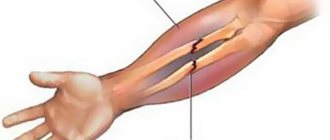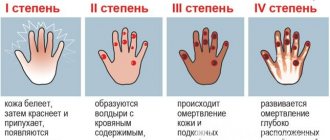Summer is a time for vacations and relaxation on the water, but this fun time is associated with many dangerous situations. One of them is drowning. Saving a drowning person is exactly the situation when you need to act as quickly as possible. Any delay or inaction can cost a human life, and the timeliness of assistance is often more important than its quality.
More than 90% of victims survive if help is provided in the first minute after drowning. If help comes within 6-7 minutes, then the chances of survival will be much lower - 1-3%. Therefore, it is very important not to panic, pull yourself together and start acting. Of course, it is better for professional rescuers to provide assistance, but if they are not nearby, it is better to try to help to the best of your ability than to do nothing.
- 2 The concept of drowning and its types
- 3 First aid for drowning
- 4 Carrying out artificial respiration
- 5 Some features of resuscitating drowning people (Video: “Rules for providing first aid to drowning people”)
Determine the type of drowning
Experts from the Russian Ministry of Emergency Situations distinguish between two options: First aid for a drowning person. They are named after the skin color of the person who has just drowned.
"Blue" drowning
It happens when a person fights for life to the last. Usually people who don’t know how to swim and accidentally find themselves in the depths drown this way. Or, for example, children falling into the pool. Or swimmers who were carried away by strong currents.
In an effort to escape, they hold their breath for a long time, but at the same time actively move, even when they find themselves under water. Oxygen is quickly consumed, and brain hypoxia occurs. The person loses consciousness, and at this moment water in large quantities penetrates the stomach and lungs. Then it is absorbed into the blood, dilutes it, and it seeps through the walls of blood vessels. Because of this, the skin acquires a characteristic bluish color.
Additionally, deadly disorders develop:
- The heart is overstrained. It is difficult for him to pump through the increased volume of blood, and besides, due to the lack of oxygen, he does not have enough energy to do this. If a person is not pulled out of the water in time and resuscitation measures are not started, the heart may stop;
- Gas exchange in the lungs worsens. The liquid that gets into them foams. This can be seen as pinkish, frothy mucus coming out of the mouth and nose when you exhale or try to cough. An additional sign is bubbling breathing, as if something is boiling in the chest. Again: in the absence of timely medical assistance, this can lead to respiratory arrest.
"Pale" drowning
It happens when a person drowns in an unconscious state. For example, if you fell into the water, slipped and hit your head on the side of the pool. Also, “pale” drowning is observed in case of shock (when a person, say, falls through the ice) or if the water is highly chlorinated.
In such situations, laryngospasm occurs - the glottis closes completely. This is a protective reaction of the body: thus blocking the flow of water into the lungs. In this case, the drowning person does not inhale the liquid, which means that it almost does not penetrate into the stomach.
"Pale" drowning is considered more favorable than "blue" drowning. Yes, a person’s breathing and blood flow completely stop, but if you start resuscitation within 5 minutes after a spasm, there will be much less severe consequences.
How to properly save a drowning person
If you see a drowning person, the first thing you need to do is call rescuers. You can swim to rescue yourself only if you are confident that you are swimming well and feel well. Under no circumstances should you swim at random and join the ranks of drowned people. It is necessary to swim up to a drowning person strictly from behind, so that he does not grab the rescuer in frantic attempts to escape. Remember, a drowning person does not control himself and can easily prevent you from swimming and even pull you under water, and it will be very difficult to free yourself from his convulsive grip.
If the drowning person has already completely immersed himself in the water, you need to swim to him along the bottom and at the same time take into account the direction of the current and its speed. When the drowning person is within reach, you need to take him under the armpits, by the arm or by the hair and pull him out of the water. In this case, it is important to push off strongly enough from the bottom and actively work with your free arm and legs.
Once you are above the water, it is important to keep the drowning person's head above the surface of the water. After this, you must try to deliver the victim ashore as quickly as possible to provide first aid .
Remove water from the lungs and stomach of a drowning person
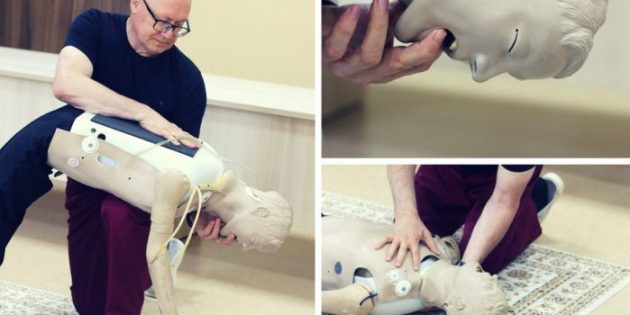
If you experience a "pale" drowning, move on to the next step.
In case of “blue”, and also if the victim is conscious, but has swallowed water, it is necessary to act as follows:
- throw the drowning person face down over your knee;
- Unclench your teeth, put two fingers in his mouth and sharply press on the root of his tongue to trigger a gag reflex.
If a person begins to vomit or has a cough, continue to press on the root of the tongue for 5-10 minutes until water stops pouring out of the mouth and nose. Your task is to help the victim get rid of the liquid that has entered the stomach and lungs as much as possible.
If neither a gag reflex nor a cough appears, and also in less complex cases, continue in accordance with the general Drowning Treatment first aid algorithm.
Actions after first aid

After the victim returns to consciousness, he is carefully covered and given hot tea.
After the victim returns to consciousness, he is dressed in dry clothes and carefully covered. For additional warmth, use a heating pad. You can improve blood circulation with a hot drink, but alcohol is strictly prohibited.
To prevent repeated loss of consciousness, the victim is carefully monitored and ammonia is offered. Before paramedics arrive and provide primary care, they give you a sedative and help you move to a more comfortable place.
If the extremities are cold, they need to be rubbed.
If necessary, begin cardiopulmonary resuscitation.
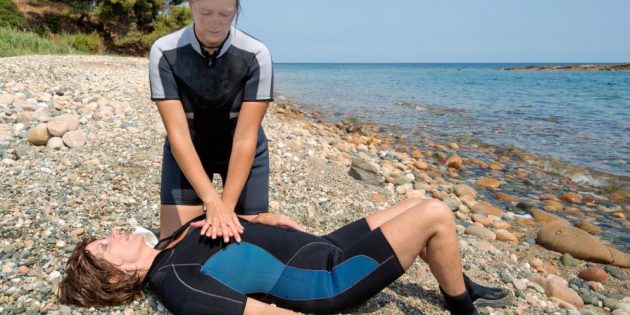
If the victim is not breathing, perform mouth-to-mouth artificial respiration.
Specialists of the Ministry of Emergency Situations of Russia recommend the following RULES FOR PROVIDING FIRST AID TO A VICTIMS ON WATER:
- Place the victim on his back on a hard surface.
- Make sure your head is slightly tilted back (chin up). This is necessary so that air enters the lungs and not the stomach.
- Cover the person's mouth with gauze or a thin handkerchief. Pinch his nose.
- Exhale forcefully into the victim's mouth. The frequency of exhalations is approximately 17 times per minute.
- Keep an eye on the victim's chest. If it goes up and down, you're doing it right.
If the drowning person also does not have a pulse, artificial respiration must be supplemented with chest compressions.
Attention! Indirect cardiac massage can be performed only when the victim really does not have a heartbeat. If the pulse is palpable, massage is prohibited!
- Place the palm of one hand in the center of your chest at the nipple line.
- Place the palm of your second hand on top of the first. If we are talking about a baby, place two fingers on the chest.
- Press on the sternum three to four times between exhalations. It is more convenient to do this together: one performs artificial respiration, the other performs massage.
First aid algorithm
The victim is taken out of the water and freed from wet clothes. If necessary, it is cut. The oral cavity is cleaned with a clean cloth or gauze. Carefully remove sand, mud or soil.
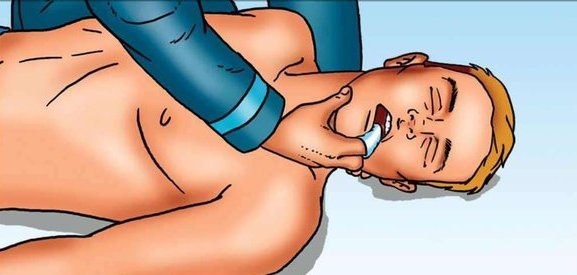
The oral cavity is cleaned with a clean cloth or gauze.
The person is turned face down and the water is removed from the lungs and stomach.
The first medical aid for drowning is to clear the lungs and stomach of water. For this, the person is placed face down on a bent knee and pressure is applied to the back, the chest is compressed in the middle. This is done until the fluid is completely removed from the organs.
Next, he is placed on a flat surface and artificial respiration is performed. It is advisable to carry out the manipulation through a rubber tube. If it is not there, the mouth of the drowned person is covered with a handkerchief or gauze. When fluid is expelled from the lungs, the head is sharply but gently turned to its side.

Next, he is placed on a flat surface and artificial respiration is performed.
After providing first aid for drowning, a person should regain consciousness, but sometimes this does not happen. Stopping breathing within 2 minutes can be fatal, so it is necessary to monitor the condition of the victim. The absence of a pulse and dilated pupils are a sign of clinical death. Then first aid for a drowning person includes indirect cardiac massage.

If there are signs of clinical death, indirect cardiac massage is performed.
Compression is done 4-5 times, followed by air injection. In just a minute, make at least 15 breaths and up to 80 pressures. Emergency care for drowning is stopped after signs of biological death appear.
These include:
- drying of the cornea;
- the cat's eye symptom persists after 15 minutes of cessation of breathing;
- there is no cardiac activity for more than 25 minutes;
- the appearance of cadaveric spots on sloping areas of the body, a gradual decrease in body temperature.
If pre-medical first aid in saving a drowning person was effective, the patient begins to breathe on his own. His condition is not yet stable and he will require assistance from medical personnel.
Continue resuscitation measures until breathing and pulse resume or an ambulance arrives.
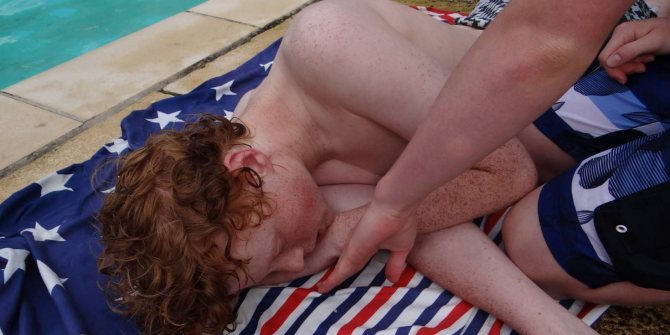
Let us repeat once again: you must call the doctors! Even if both you and the victim himself think that nothing terrible happened - they say that he was pulled out in time and he only “drank some water.” This is the very case when it is better to be on the safe side.
If breathing and pulse have been restored, and if the drowning person feels well, lay him on his side and wait for the doctors. Doctors will assess the victim’s condition and either hospitalize him or tell him what to do next.
The concept of drowning and its types
In order to effectively provide first aid to a drowning person, it is necessary to understand what drowning is and what types of it doctors distinguish. Drowning is a condition in which the airways become blocked, preventing air from entering the lungs, resulting in oxygen deprivation. There are three types of drowning and they all have their own characteristics.
White asphyxia or imaginary drowning is a reflex cessation of breathing and heart function. Typically, with this type of drowning, a very small amount of water enters the respiratory tract, which leads to spasm of the glottis and cessation of breathing. White asphyxia is relatively safe for humans, since the chances of returning to life remain even 20-30 minutes after immediate drowning.
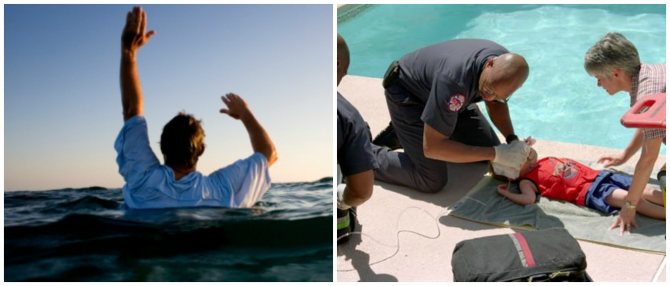
Blue asphyxia is real drowning, which occurs when water enters the alveoli. Typically, drowning people have a blue tint to their ears and face, and their fingertips and lips are purple-blue. It is possible to save such a victim if only 4-6 minutes have occurred since the moment of drowning.
Drowning when the function of the nervous system is depressed usually occurs after cold shock or in a state of severe alcohol intoxication. Respiratory and cardiac arrest usually occurs 5-12 minutes after drowning.
What is first aid for drowning
Before starting resuscitation measures, it is important to understand what processes occur in the body during drowning.
If fresh water enters the lungs in large quantities, the cyclical contraction of the heart ventricles is disrupted, extensive edema develops, and the function of the systemic circulation ceases. When salt water enters the body, the blood thickens pathologically, which leads to stretching and rupture of the alveoli, swelling of the lungs, impaired gas exchange and subsequent rupture of the myocardium with a fatal outcome for the patient. In both cases, in the absence of first aid, the victim may die. This cannot be allowed. First aid for drowning involves a special set of resuscitation measures aimed at forcing the passage of water in order to maintain the functionality of internal organs and systems. It is important to provide assistance to a drowning person no later than 6 minutes from the moment of loss of consciousness. Otherwise, extensive cerebral edema develops and the victim dies. Thanks to compliance with the algorithm of actions, the statistics of drownings decreased.
Some features of resuscitating drowning people (Video: “Rules for providing first aid to drowning people”)
There are quite a lot of prejudices and rumors associated with rescuing drowning people. We will remind you of some rules and features of resuscitation measures in case of drowning. It is important to remember these rules and use them in a real situation.
Resuscitation measures must be carried out even if a person has been under water for a long time. Cases of revival with complete restoration of the patient’s condition even after an hour of being under water are described. Therefore, if a person spent 10-20 minutes under water, this does not mean that he died and there is no need to save him, this is especially important when resuscitating children.
If during resuscitation measures the stomach contents are released into the oropharynx, it is necessary to carefully turn the victim to one side, trying to ensure that the relative position of the head, neck and torso does not change, then clear the mouth and, turning it to its original position, continue resuscitation.
If there is a suspicion of damage to the spine, especially its cervical region, then airway patency must be ensured without tilting the victim’s head, but simply by using the technique of “pushing the lower jaw forward.” If this action does not help, then you can throw back your head, despite suspicions of spinal injuries, since ensuring airway patency is a priority action when rescuing unconscious patients.
Resuscitation efforts can be stopped only if the signs of respiratory failure have completely disappeared . If there is a violation of the respiratory rhythm, rapid breathing or severe cyanosis, it is necessary to continue resuscitation efforts.
Quick tips for rescuing a drowning person and providing assistance
- You should not rush to the aid of a drowning person if you are a poor swimmer or simply unsure of your abilities.
- During transportation of the victim, you should ensure that his mouth and nose are constantly above the water level - this will protect the person from additional infusion of liquid.
- During artificial respiration, a lot of air enters the person’s stomach and bloating occurs, which can delay the onset of consciousness, so you need to periodically apply a little pressure on the victim’s pancreas in order to free it from excess air.
- You cannot press on the chest and blow air into a person at the same time. This should be done alternately: 5 presses and one inhalation.
What do you need to know to avoid drowning?
In most cases, the cause of drowning is a gross violation of the rules of behavior on the water. It is important for every person going to the beach to know what wrong actions can cause a tragedy.
It is prohibited to be in the water while intoxicated. In addition to the fact that under the influence of alcohol the sense of reality is distorted, it is impossible to predict the body’s reaction to the presence of ethyl alcohol in the blood.
When visiting a pond for the first time, it is forbidden to dive until you have thoroughly explored the area - even a small piece of snags that you can catch your foot on or hit your head can cause sudden death. Games on the water should not be associated with comic drowning or force. Pay attention to what is happening around you - boats, catamarans and yachts are potential sources of danger. You should not swim far from the coastline, even if you have good swimming skills, and you should not leave children unattended - an adult should always be nearby, and not just watch from the shore.
How to prevent drowning
To prevent disaster, you need to remember the following:
- If, while swimming in a pond, you realize that you have not calculated your strength and are starting to drown, then, first of all, you need to try to relax and lie on your back, and then call someone for help.
- Children should not be allowed to bathe independently without adult supervision.
- You cannot dive headfirst into unfamiliar bodies of water without knowing the proper depth and bottom.
- You should not swim while intoxicated or immediately after eating.
- It is not recommended to swim near bridges, cliffs, underwater holes, etc.
- You should not enter the pond after being in the sun for a long time, or if you are very tired.
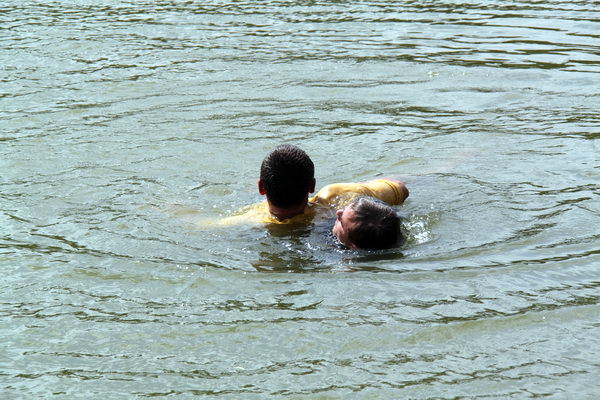
Terminology

Previously, this definition sounded like death from water (or other liquids) entering the respiratory tract and lungs. But it turned out to be not accurate enough. The modern formulation implies that the liquid becomes a barrier to air entering the respiratory tract. But this does not mean that a person must die. In any case, it will be considered drowning.
Secondary drowning
Quite a dangerous phenomenon due to its non-obviousness. It usually occurs after the primary one and carries a hidden threat that can only be detected by careful observation. The mechanism by which this phenomenon occurs is quite simple. After removing water from the lungs, some fluid may remain inside in the form of droplets, which will interfere with the proper functioning of the respiratory system. This will lead to a depletion of oxygen in the body and a subsequent lack of oxygen in the brain. In adults, this problem is solved by the body itself, but for children it poses an increased danger, since the area of their lungs is relatively smaller and any violation will lead to prolonged oxygen starvation. The secondary type of drowning can be detected over a time period from an hour to a day.
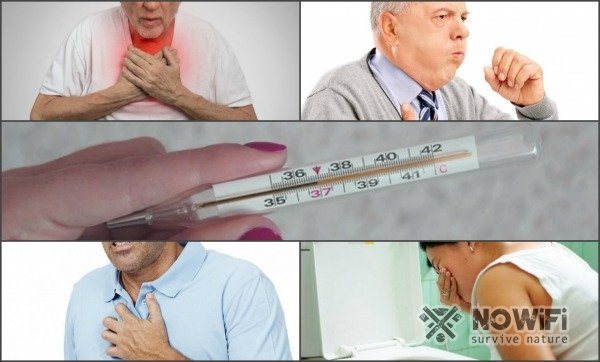
Figure 6. If these symptoms appear after drowning, call an ambulance immediately
Symptoms to look out for (Figure 6):
- Difficulty breathing;
- Prolonged cough that does not go away for several hours;
- Pain in the chest cavity;
- A slight temperature deviation from the norm;
- Sudden crippling fatigue accompanied by drowsiness;
- Impaired thinking abilities and odd behavior;
- Nausea and heaviness in the stomach.
When faced with these symptoms, it is necessary to call an ambulance, but it may not always arrive on time (Figure 7).

Figure 7. When calling an ambulance, do not rely only on its quick arrival, provide all possible CORRECT first aid
When you are pressed for time, do the following:
- Sit down and ask your child to lie on your back, feet up;
- Grab your hips with your hands and secure them on your shoulders;
- Then stand up straight and ask the child to cough while shaking him.
What is drowning
The World Health Organization (WHO) defines drowning as respiratory distress caused by immersion or prolonged exposure to water. As a result, breathing problems and asphyxia may occur. If first aid to a drowning person is not provided on time, death occurs. How long can a person go without air? The brain can function for only 5-6 minutes during hypoxia, so it is necessary to act very quickly, without waiting for the ambulance team.
There are several reasons for this situation, but not all of them are accidental. Sometimes incorrect human behavior on the surface of the water leads to undesirable consequences. Key factors include:
- injuries from diving in shallow water, in unexplored places;
- alcohol intoxication;
- emergency situations (seizures, heart attack, diabetic or hypoglycemic coma, stroke);
- inability to swim;
- neglect of a child (when children drown);
- getting into whirlpools, storm.
Signs of drowning
The symptoms of drowning are easy to spot. The victim begins to flounder or gasps for air like a fish. Often a person uses all his energy to keep his head above water and breathe, so he cannot scream for help. Spasm of the vocal cords may also occur. A drowning man panics and gets lost, which reduces his chances of self-rescue. When the victim has already been pulled out of the water, the fact that he was drowning can be determined by the following symptoms:
- bloating;
- chest pain;
- blue or bluish tint to the skin;
- cough;
- shortness of breath or shortness of breath;
- vomiting.
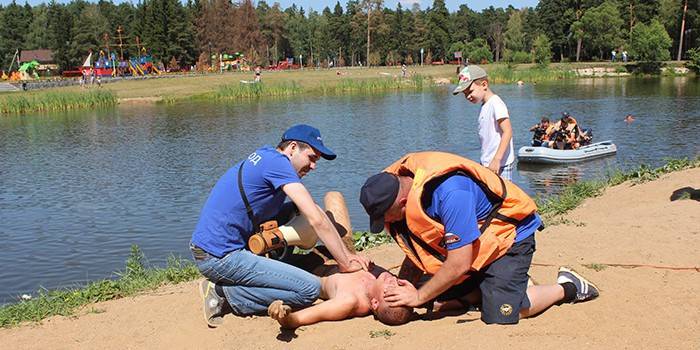
Rescue of a drowning man
Anyone can notice the victim, but it is important to provide first aid in a short time, because someone’s life depends on it. When on the shore, the first thing to do is call a lifeguard for help. The specialist knows exactly how to act. If he is not nearby, you can try to pull the person out yourself, but you need to remember the danger. The drowning person is in a stressful state, his coordination is impaired, so he can involuntarily cling to the rescuer, not allowing him to grab him. There is a high probability of drowning together (if they behave incorrectly in the water).

